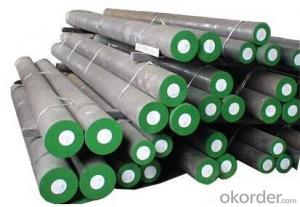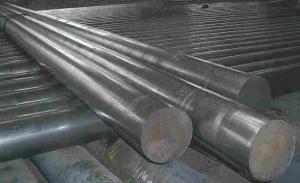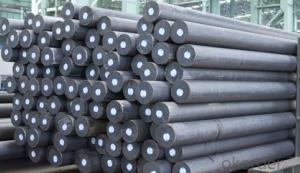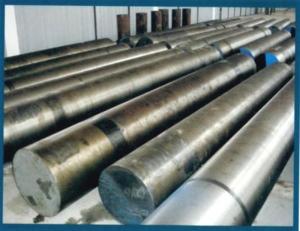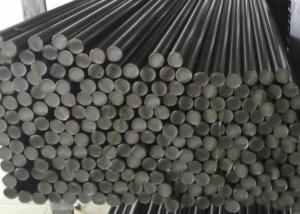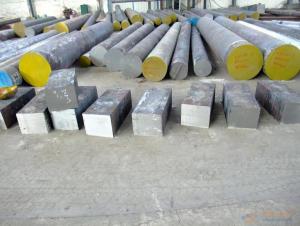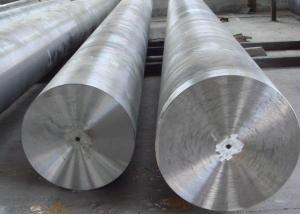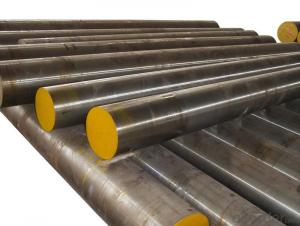Grade AISI5152 CNBM Alloy Special Steel Round Bar
- Loading Port:
- Shanghai
- Payment Terms:
- TT OR LC
- Min Order Qty:
- 30 m.t
- Supply Capability:
- 10000 m.t/month
OKorder Service Pledge
OKorder Financial Service
You Might Also Like
Item specifice
Specifications of Round Bar
Diameter: 4mm - 800mm
Length: Max 12m
Heat Treatment: Normalizing, Annealing, Tempering, Quenching
Chemical Composition and Mechanical Properties
Chemical Composition | Mechanical Properties(In Quenched & Tempered State) | ||
C | 0.17-0.23 | Tensile strength(MPA) | 930 |
Si | 0.17-0.37 | Yield strength (MPA) | 735 |
Mn | 0.90-1.20 | Elongation(δ5/%) | 10 |
Cr | 0.90-1.20 | Reduction in Area (ψ/%) | 45 |
Mo | 0.05 | Impact (J) | 47 |
P | ≤0.030 |
|
|
S | ≤0.030 |
|
|
V | --- | Hardness | 187HBW |
Our Featured Products
Alloy steel: Combination of steel / Bearing steel// Spring steel/ Cr- mo steel
GB 20Cr/ 40Cr / 42CrMo / 35CrMo/ 20CrMn/GCr15/30CrMnTi…
ASTM 5120 /5140 / 4140/ 4135/ 5152/52100…
JIS SCr420H/ SCr440/ SCM3/ SUP9/SUJ2…
Carbon steel: Carbon tool steel /Carbon Structural Steel
GB 20/ 35 /45/…
ASTM 1020/ 1030/1045…
JIS S20C/ S30C / S45C…
Usage and Applications of Round Bar
1. Chinese standard steel bar is often used where large amounts of steel need to be formed, for example as structural steel.
2. And we can use this kind of product on the performance of the mechanical parts if the demand is not very high.
3. Steel round bar is used in construction and a large number of architectural and engineering structures.
Packaging & Delivery of Round Bar
Packaging Detail: All goods are packed in bundle with steel strips and shipped by break bulk vessel or container (depend on target market and different ports)
Delivery Detail: 15~45 days
Trade terms: FOB, CFR, CIF
MOQ: 30 metric tons per specification; we can negotiate the quantity if the specification is normal or we have stock of one specification.
Weight: Theprice invoicing on theoretical weight basis or actual weight basis depends on customer’s request.
Shipment: The shipment of bulk break or container is depends on customer’s request and the situation of the port of destination.
Documents given: Full set of original clean on board bill of lading; Original signed commercial invoice; Original packing list; Policy of insurance; Certificate of origin and what the target market needs.
Production Flow of Round Bar
1. The common processes are preheated forging quenching, dual refinement solution process, cooling quenching and isothermal quenching. We use heat treatment for dual refinement solution process.
2. Material prepare (billet) — heat up — rough rolling — precision rolling — cooling — packing — storage and transportation
FAQ:
Q1: Why buy Materials & Equipment from OKorder.com?
A1: All products offered byOKorder.com are carefully selected from China's most reliable manufacturing enterprises. Through its ISO certifications, OKorder.com adheres to the highest standards and a commitment to supply chain safety and customer satisfaction.
Q2: How do we guarantee the quality of our products?
A2: We have established an advanced quality management system which conducts strict quality tests at every step, from raw materials to the final product. At the same time, we provide extensive follow-up service assurances as required.
Q3: How soon can we receive the product after purchase?
A3: Within three days of placing an order, we will begin production. The specific shipping date is dependent upon international and government factors, but is typically 7 to 10 workdays.
Q4: What makes stainless steel stainless?
A4: Stainless steel must contain at least 10.5 % chromium. It is this element that reacts with the oxygen in the air to form a complex chrome-oxide surface layer that is invisible but strong enough to prevent further oxygen from "staining" (rusting) the surface. Higher levels of chromium and the addition of other alloying elements such as nickel and molybdenum enhance this surface layer and improve the corrosion resistance of the stainless material.
Q5: Can stainless steel rust?
A5: Stainless does not "rust" as you think of regular steel rusting with a red oxide on the surface that flakes off. If you see red rust it is probably due to some iron particles that have contaminated the surface of the stainless steel and it is these iron particles that are rusting. Look at the source of the rusting and see if you can remove it from the surface.
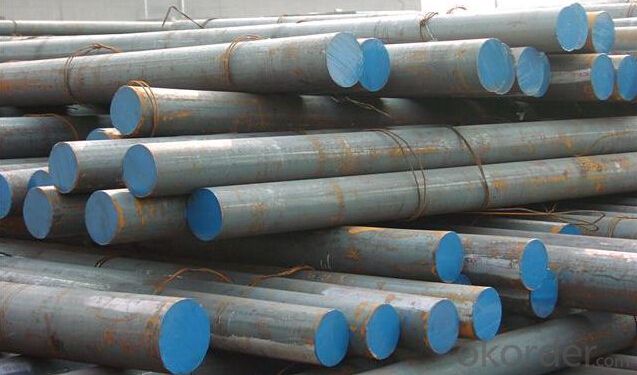
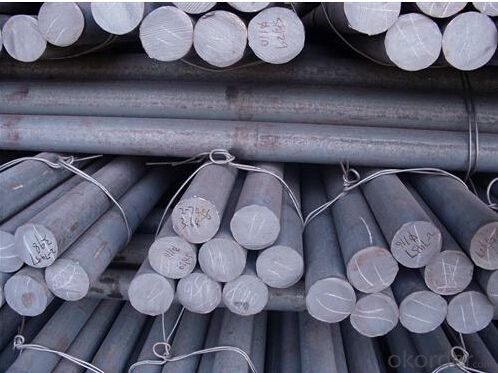
- Q:Can special steel be used for making mining equipment?
- Yes, special steel can be used for making mining equipment. Special steel refers to steel alloys that have been specifically designed and manufactured to possess certain properties and characteristics that make them suitable for specific applications. In the case of mining equipment, special steel is often used due to its exceptional strength, toughness, and resistance to wear and corrosion. Mining equipment is subjected to extreme conditions, such as heavy loads, impact, abrasion, and exposure to harsh environments. Special steel grades, such as high-strength low-alloy (HSLA) steel, tool steel, and wear-resistant steel, are commonly employed in the manufacturing of mining equipment to ensure their durability and performance under these demanding circumstances. Special steel allows mining equipment to withstand the stresses and strains encountered during excavation, hauling, and processing of minerals. It can be used for the fabrication of components like bucket teeth, drill bits, cutting edges, and crusher parts, which need to resist wear and maintain their strength even when exposed to abrasive materials. Moreover, certain types of special steel, such as stainless steel, are particularly suitable for mining operations where equipment comes into contact with corrosive substances like acids or moisture. Stainless steel exhibits excellent corrosion resistance, making it suitable for applications such as pipes, tanks, and conveyors used in mining operations. In conclusion, special steel can indeed be used for making mining equipment. Its superior strength, toughness, wear resistance, and corrosion resistance make it a preferred choice for manufacturing various components and structures used in the mining industry.
- Q:What are the factors to consider when selecting special steel for a specific application?
- When choosing special steel for a particular use, there are several critical factors to take into account: 1. Mechanical properties play a crucial role in determining the steel's suitability for the application. Strength, hardness, toughness, and ductility are all important considerations. Matching the steel's mechanical properties to the specific requirements of the application is essential to achieve optimal performance and ensure safety. 2. The steel's resistance to corrosion is another key factor to consider. Different environments, such as marine, chemical, or high-temperature conditions, may necessitate the use of corrosion-resistant alloys or coatings. This is vital to ensure the steel's longevity and reliability in service. 3. Temperature resistance is crucial in many applications. The steel must be able to withstand high or low temperatures without compromising its mechanical properties. Factors like thermal expansion, thermal conductivity, and resistance to thermal fatigue should be taken into account to ensure effective performance in the intended environment. 4. If welding or fabricating the steel into complex shapes is necessary, the ease of weldability and fabricability becomes an important consideration. Certain steels may require specialized welding techniques or preheating to prevent cracking or distortion during fabrication. 5. Cost is a significant consideration as well. It is important to find a balance between the desired properties of the steel and the available budget. This ensures cost-effectiveness without compromising performance or safety. 6. The availability of the chosen steel grade in the required form, size, and quantity is another critical factor. It is crucial to ensure that the selected steel can be easily sourced and obtained within the required timeframe. This helps to avoid project delays or cost overruns. 7. Compliance with industry-specific standards, specifications, or regulations is essential. Depending on the industry or application, there may be specific requirements that the steel must meet. Selecting a steel grade that complies with these standards is necessary to ensure compliance and maintain necessary certifications or approvals. By considering these factors, engineers and manufacturers can make well-informed decisions when choosing special steel for specific applications. This ensures optimal performance, durability, and safety.
- Q:How does special steel perform in high-temperature mechanical fatigue conditions?
- Special steel performs well in high-temperature mechanical fatigue conditions due to its unique composition and properties. It exhibits excellent strength, toughness, and heat resistance, enabling it to withstand cyclic loading and high temperatures without experiencing significant degradation or failure. The special steel's exceptional performance in such conditions makes it an ideal choice for applications that involve continuous exposure to elevated temperatures and mechanical stresses, ensuring long-term reliability and durability.
- Q:What are the different surface hardening techniques for special steel?
- There are several surface hardening techniques for special steel, including carburizing, nitriding, induction hardening, flame hardening, and laser hardening.
- Q:How does special steel contribute to the automotive material recycling?
- Special steel contributes to automotive material recycling in several ways. Firstly, special steel is highly durable and strong, making it ideal for use in critical automotive components such as engine parts, chassis, and suspension systems. This durability ensures that these components have a longer lifespan, reducing the frequency of replacements and minimizing waste. Additionally, special steel is highly recyclable. It can be easily melted down and reused without losing its inherent properties. This makes it an excellent choice for automakers looking to incorporate recycled materials into their production processes. By utilizing recycled special steel, the automotive industry can reduce the demand for virgin raw materials, conserve energy, and decrease greenhouse gas emissions associated with mining and production. Moreover, special steel's high strength-to-weight ratio allows for the production of lighter vehicles, enhancing fuel efficiency and reducing carbon emissions during the vehicle's operational phase. This aspect of special steel contributes to the overall sustainability of the automotive industry and supports the goals of a circular economy by promoting resource efficiency and waste reduction. Overall, special steel plays a vital role in automotive material recycling by enabling durable and long-lasting components, promoting the use of recycled materials, and contributing to the development of more sustainable and environmentally friendly vehicles.
- Q:What are the specific requirements for special steel used in the power transmission industry?
- The durability, strength, and resistance to various environmental factors are crucial requirements for special steel used in the power transmission industry. Power transmission equipment operates under high loads, extreme temperatures, and corrosive conditions, making these requirements essential. Here are some specific requirements for special steel in this industry: 1. High strength is necessary for the steel to withstand the mechanical stresses and loads imposed by power transmission equipment. This ensures effective weight carrying and resistance to deformation or failure. 2. Sufficient hardness is needed to resist wear and abrasion. The constant friction and contact in power transmission equipment require steel that can withstand these forces without quick deterioration. 3. Excellent resistance to corrosion and rusting is crucial due to the frequent exposure of power transmission equipment to moisture, chemicals, and other corrosive substances. The steel must withstand these conditions without deteriorating. 4. High heat resistance is necessary as power transmission equipment operates at high temperatures, especially in power generation and distribution. This prevents deformation, strength loss, and failure under extreme thermal conditions. 5. Good electrical conductivity is required for certain power transmission components to ensure efficient electricity transmission. Steel used for conductive purposes must have low electrical resistance to minimize power loss during transmission. 6. Excellent fatigue resistance is important for special steel used in the power transmission industry. This means the steel can withstand repeated cycles of stress and strain without cracking or breaking, ensuring long-term reliability and durability. 7. Dimensional stability is crucial for the steel to maintain its intended design and functionality over time, even under different operating conditions. In conclusion, the specific requirements for special steel in the power transmission industry include high strength, hardness, corrosion resistance, heat resistance, electrical conductivity, fatigue resistance, and dimensional stability. These requirements allow the steel to withstand demanding operational conditions and provide reliable and efficient power transmission.
- Q:What are the requirements for special steel used in wind turbines?
- The requirements for special steel used in wind turbines are crucial for ensuring the reliability, efficiency, and durability of these large-scale renewable energy systems. Here are some of the key requirements: 1. Strength and Durability: Special steel for wind turbines must possess high strength and durability to withstand the harsh operating conditions, including strong winds, vibrations, and extreme temperature variations. It should have a high fatigue resistance to endure cyclic loading over the turbine's operational life, which can be up to 20-25 years. 2. Corrosion Resistance: Wind turbines are often installed in coastal or offshore environments, where they are exposed to corrosive saltwater and salt-laden air. Therefore, the special steel used in wind turbines must have excellent corrosion resistance to prevent degradation and ensure long-term performance. 3. Weldability: The steel used in wind turbines should be suitable for welding processes to facilitate the fabrication and assembly of the turbine components. Good weldability allows for efficient construction and maintenance, reducing downtime and associated costs. 4. Low Temperature Toughness: Wind turbines are often located in regions with low temperatures, such as arctic or mountainous areas. Special steel used in these turbines should possess good low-temperature toughness, ensuring its mechanical properties remain intact even in cold climates. 5. Magnetic Properties: Wind turbines employ various electrical components, such as generators and transformers, where electromagnetic fields are present. Special steel used in these components should have specific magnetic properties to minimize energy losses and maximize the efficiency of the electrical system. 6. Cost-effectiveness: While meeting all the above requirements, the special steel used in wind turbines should also be cost-effective. It should offer a good balance between performance and cost to ensure the economic viability of wind energy projects. Meeting these requirements is essential to ensure the long-term operation and sustainability of wind turbines, enabling them to generate clean and renewable energy efficiently.
- Q:How does special steel contribute to the electrical conductivity of products?
- Special steel can contribute to the electrical conductivity of products in several ways. Firstly, special steel alloys can be formulated with specific chemical compositions that enhance their electrical conductivity. For example, adding elements such as copper, silver, or nickel to the steel can increase its electrical conductivity by providing more pathways for the flow of electric current. Additionally, the microstructure of special steel can be manipulated to improve electrical conductivity. By controlling the grain size and orientation of the steel, it is possible to reduce the resistance to the flow of electrons, thereby increasing the overall conductivity of the material. Furthermore, special steel can be heat treated or subjected to other processes to enhance its electrical conductivity. Heat treatment techniques like annealing or tempering can help to remove impurities and improve the crystal structure of the steel, resulting in improved electrical conductivity. Moreover, special steel can also be designed to have low magnetic permeability, which means it exhibits less resistance to the flow of magnetic fields. This property is beneficial for applications where electromagnetic interference needs to be minimized, such as in electrical connectors or transformers. In summary, special steel contributes to the electrical conductivity of products through various means, including chemical composition, microstructural control, heat treatment, and low magnetic permeability. By optimizing these factors, special steel can significantly enhance the performance of electrical components and systems.
- Q:How does special steel contribute to the electrical industry?
- Special steel plays a crucial role in the electrical industry by providing the necessary materials for the production of various electrical components and infrastructure. It offers high strength, thermal resistance, and corrosion resistance, making it ideal for manufacturing transformers, power generators, electrical motors, and transmission lines. Additionally, special steel enables the development of advanced electrical technologies, such as superconductors and magnetic materials, which enhance the efficiency and performance of electrical systems. Overall, special steel contributes to the electrical industry by ensuring the reliability, durability, and innovation of electrical equipment and infrastructure.
- Q:How does special steel perform in nuclear applications?
- Due to its exceptional properties and performance, special steel holds significant value in nuclear applications. Nuclear reactors operate under extreme conditions, enduring high temperatures, pressures, and radiation exposure. Designed specifically for these demanding circumstances, special steel, also known as nuclear-grade steel or reactor-grade steel, can withstand them. One of the primary characteristics of special steel lies in its remarkable strength and toughness. This quality enables it to resist deformation and fractures, even under the intense stress and pressure present in nuclear reactors. Additionally, special steel exhibits superior heat resistance, ensuring its structural integrity remains intact at elevated temperatures. This feature is critical to prevent any potential failures or structural damage that could jeopardize the safety and efficiency of the nuclear system. Moreover, special steel possesses exceptional resistance to corrosion and oxidation. The highly corrosive environments within nuclear reactors, caused by various chemical compounds and high-temperature water or steam, make this corrosion resistance indispensable. It ensures the longevity and reliability of reactor components while minimizing the risk of radioactive material release. Furthermore, special steel is designed to have low neutron absorption properties. By reducing neutron absorption, special steel helps optimize the performance and efficiency of the nuclear system. This is vital as neutron absorption can lead to the formation of unwanted isotopes that could interfere with nuclear reactions or contribute to the production of radioactive waste. Overall, special steel is a critical material in nuclear applications. Its provision of necessary strength, heat resistance, corrosion resistance, and low neutron absorption ensures the safe and efficient operation of nuclear reactors. Its exceptional performance guarantees the integrity of the system, minimizes accident risks, and contributes to the overall sustainability of nuclear energy.
1. Manufacturer Overview |
|
|---|---|
| Location | |
| Year Established | |
| Annual Output Value | |
| Main Markets | |
| Company Certifications | |
2. Manufacturer Certificates |
|
|---|---|
| a) Certification Name | |
| Range | |
| Reference | |
| Validity Period | |
3. Manufacturer Capability |
|
|---|---|
| a)Trade Capacity | |
| Nearest Port | |
| Export Percentage | |
| No.of Employees in Trade Department | |
| Language Spoken: | |
| b)Factory Information | |
| Factory Size: | |
| No. of Production Lines | |
| Contract Manufacturing | |
| Product Price Range | |
Send your message to us
Grade AISI5152 CNBM Alloy Special Steel Round Bar
- Loading Port:
- Shanghai
- Payment Terms:
- TT OR LC
- Min Order Qty:
- 30 m.t
- Supply Capability:
- 10000 m.t/month
OKorder Service Pledge
OKorder Financial Service
Similar products
New products
Hot products
Related keywords
